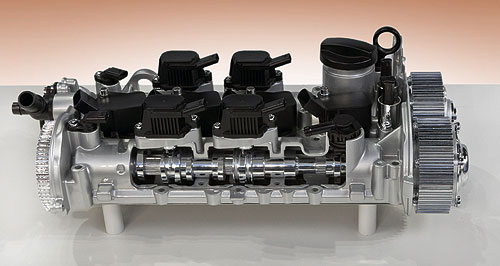Make / Model Search
News - General News - FuelsDiesel tech to benefit petrol enginesEconomy drive: Volkswagen’s 1.4 TSI ‘EA211’ engine with ‘active cylinder management’. Cylinder deactivation and diesel tech among key trends for petrol engines26 Feb 2013 By JOHN MELLOR PETROL engines are going to get smaller over the next five years and borrow heavily from diesel engine technology, to the point where they may become as efficient as diesels but cheaper and cleaner, according to international expert Anup Bandivadekar. Dr Bandivadekar is the passenger vehicles program director of the International Council on Clean Transportation (ICCT), an advisory body set up as a research resource for regulators worldwide developing environmental policy on transport fuel use and emissions. He was commenting on the relatively recent surge by car-makers globally to launch vehicles with dramatic reductions in CO2 emissions and fuel consumption which are starting to show overall energy and pollution improvements in vehicle fleets in key western markets. Dr Bandivadekar will be a keynote speaker at the forthcoming Cars of Tomorrow conference to be held in Melbourne on March 14 as part of the Victorian government’s Automotive Week. He told GoAuto that the rush of improvement has resulted from a change of focus by car-makers from improving performance to improving drivetrain efficiency.  Left: Dr Anup Bandivadekar. Left: Dr Anup Bandivadekar.“Newer tools in design are enabling these technologies to come to market faster, but what has really changed dramatically is how these technologies are getting deployed,” he told us. “In the decades of the 1980s and 1990s, even though technology was advancing at a steady pace, most of the technology improvements, with a few exceptions, went to improving vehicle performance – speed, horsepower, creature comfort levels, additional electronics and gadgetry and zoom-zoom type of performance aspects. “This past decade has shifted in favour of using technology improvements for reducing fuel consumption.” He said this reflects increasing fuel prices around the world and renewed interest in regulation of fuel efficiency and emissions, especially in the United States, Japan and Europe, and that the pace of change has “surprised us”. “In the US, for example, the deployment of turbochargers and six-speed transmissions has gone up at a faster rate than we expected. “Ford, for example, has used the eco-boost V6 engine as an alternative to the V8 in the F150, which is the workers’ truck and the largest-selling light vehicle in the US. “This is a segment that is very conscious of what they buy and are proud of what they buy. Ford expected some sort of penetration, but now it is approaching the high 40s (per cent share). That is pretty astounding.” Dr Bandivadekar said the largest improvements in vehicle engines in the next few years would come from smaller gasoline engines using diesel engine technology – turbocharging, direct injection, exhaust gas recirculation and intercoolers – without the particulate issues of diesels. “This will bring gasoline engines within earshot of diesel efficiency at a lower cost overall and with less emission challenges than diesels. “Downsizing will be by far the largest component of it in the next four or five years. We will see a lot of downsizing taking place while keeping the performance in terms of zero-to-60 miles per hour acceleration, or 60-to-80 passing acceleration, or the towing ability and ‘gradeability’ of trucks keeping these characteristics constant. “Three-cylinder engines are not uncommon in Europe now and Volkswagen on the new Golf has introduced cylinder-deactivation on a four-cylinder engine which has so far been in play on pick-ups trucks and six- and eight-cylinder engines.” He said it was significant that Volkswagen was prepared to introduce such technology on one of the world’s largest-selling vehicles. The company will also slot the 1.4 TSI ‘EA211’ four-cylinder engine with ‘active cylinder management’ into the forthcoming Polo BlueGT, with the technology directly reducing fuel consumption by a claimed 0.4 litres per 100km on the NEDC driving cycle. The light hatch’s engine produces 103kW of power but can achieve a combined fuel economy figure of just 4.7L/100km – equivalent to 108g/km of CO2.  Read more |
Click to shareGeneral News articlesResearch General News Motor industry news |










Facebook Twitter Instagram